
The geometer moths are moths belonging to the family Geometridae of the insect order Lepidoptera, the moths and butterflies. Their scientific name derives from the Ancient Greek geo γεω, and metron μέτρον "measure" in reference to the way their larvae, or inchworms, appear to measure the earth as they move along in a looping fashion. Geometridae is a very large family, containing around 23,000 described species; over 1400 species from six subfamilies are indigenous to North America alone. A well-known member is the peppered moth, Biston betularia, which has been the subject of numerous studies in population genetics. Several other geometer moths are notorious pests.

Doidae is a small family of Lepidoptera with an exclusively New World distribution, with species occurring in Central America, the south-western United States, and northern South America.

The Bistonini are a tribe of geometer moths in subfamily Ennominae. As numerous ennomine genera have not yet been assigned to a tribe, the genus list is preliminary. In addition, the entire tribe is sometimes merged into a much-expanded Boarmiini. In other treatments, the Erannini are included in the present group.
Evita is a monotypic moth genus in the family Geometridae described by Hahn William Capps in 1943. Its only species, Evita hyalinaria, was first described by Grossbeck in 1908. It is found in southwestern North America.

Anageshna is a monotypic moth genus of the family Crambidae described by Eugene G. Munroe in 1956. Its only species, Anageshna primordialis, the yellow-spotted webworm, was described by Harrison Gray Dyar Jr. in 1907. It is found in the US states of Alabama, Arkansas, Arizona, Florida, Georgia, Iowa, Illinois, Kansas, Louisiana, Massachusetts, Maryland, Maine, Minnesota, Missouri, Mississippi, North Carolina, New Hampshire, New Jersey, New York, Ohio, Oklahoma, Pennsylvania, South Carolina, Texas, Virginia and West Virginia.
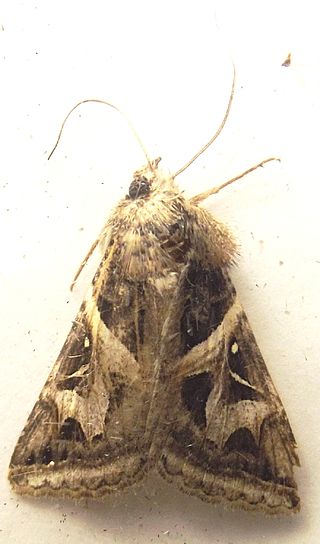
Ianius is a monotypic moth genus in the family Erebidae described by Richards in 1939. Its only species, Ianius mosca, was first described by Harrison Gray Dyar Jr. in 1910. It is found in Mexico and the southern United States, where it has been recorded from Texas.
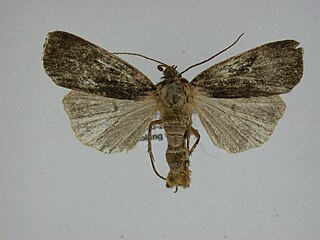
Pseudohermonassa bicarnea, the pink-spotted dart, is a moth of the family Noctuidae. The species was first described by Achille Guenée in 1852. It is found in eastern North America, and as far west as south-central Saskatchewan and central North Dakota, south to western North Carolina. It has recently been recorded from Tennessee.

Eutricopis nexilis, the white-spotted midget, is a moth of the family Noctuidae. The species was first described by Herbert Knowles Morrison in 1875. It is found in North America from Nova Scotia and New England west across southern Canada to southern Vancouver Island, north to Yukon and south in the mountains to California and Colorado.

Redectis vitrea, the scalloped snout or white-spotted redectis, is a litter moth of the family Erebidae. The species was first described by Augustus Radcliffe Grote in 1878. It is found in the United States from Illinois to south-eastern Massachusetts, south to Texas and Florida.

Spargaloma is a monotypic moth genus in the family Erebidae. Its only species is Spargaloma sexpunctata, the six-spotted gray. Both the genus and species were first described by Augustus Radcliffe Grote in 1873. It is found from coast to coast in lower Canada south in the east to Florida, Mississippi and Arkansas, in the west to California.
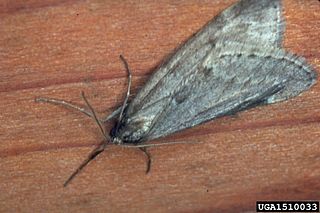
Alsophila pometaria, the fall cankerworm, is a moth of the family Geometridae. It is found in North America from Nova Scotia west to Alberta, south to Colorado and California and zones of Spain

Paleacrita vernata, the spring cankerworm, is a moth of the family Geometridae. The species was first described by William Dandridge Peck in 1795. It is found in North America from the Atlantic Ocean west to Alberta, Texas and California.
Barberia is a genus of snout moths. It was described by Harrison Gray Dyar Jr. in 1905 and contains the species Barberia affinitella. It is found in the southern United States from California to Texas.
Rumatha bihinda is a species of snout moth in the genus Rumatha. It was described by Harrison Gray Dyar Jr. in 1922. It is found in North America, including California, Texas, New Mexico, Arizona and Nevada.
Gazoryctra roseicaput is a moth of the family Hepialidae. It was described by Berthold Neumoegen and Harrison Gray Dyar Jr. in 1893. It is known from the mountains of western North America, including Washington, Oregon, British Columbia and Alberta.
Donacaula nitidellus is a moth in the family Crambidae. It was described by Harrison Gray Dyar Jr. in 1917. It is found in North America, where it has been recorded from Alberta, Alabama, Connecticut, Georgia, Maryland, Massachusetts, Mississippi, New Jersey, New York, North Carolina, South Carolina and Texas.
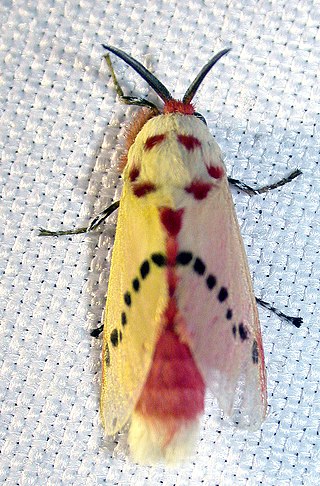
Trosia dimas, the rosy ermine, is a moth in the family Megalopygidae. It is found in Colombia, Venezuela, Ecuador, Brazil, and Peru.
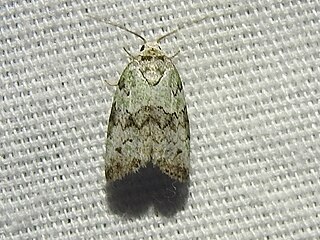
Afrida ydatodes, or Dyar's lichen moth, is a species of moth in the family Nolidae. It was described by Harrison Gray Dyar Jr. in 1913 and is found in North America, where it has been recorded from Alabama, Florida, Mississippi, North Carolina and Texas.
Paleacrita longiciliata is a species of geometrid moth in the family Geometridae. It is found in North America.

Rosa setigera, commonly known as the climbing rose, prairie rose, and climbing wild rose, is a species of shrub or vine in the Rosaceae (rose) family native to central and eastern North America.














